The AMD Trinity Review (A10-4600M): A New Hope
by Jarred Walton on May 15, 2012 12:00 AM ESTAMD Trinity General Performance
Starting as usual with our general performance assessment, we’ve got several Futuremark benchmarks along with Cinebench and x264 HD encoding. The latter two focus specifically on stressing the CPU while PCMarks will cover most areas of system performance (including a large emphasis on storage) and 3DMarks will give us a hint at graphics performance. First up, PCMark 7 and Vantage:
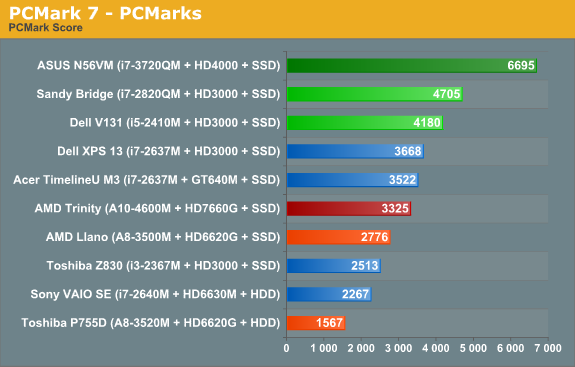
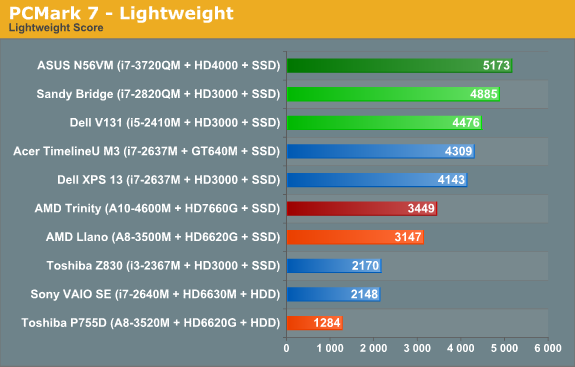
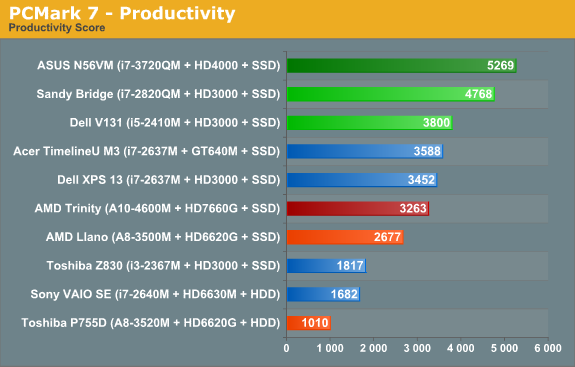

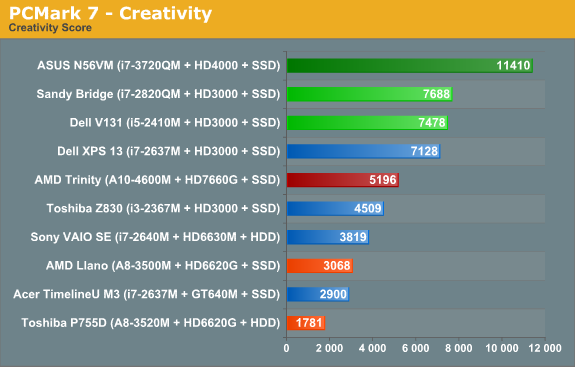
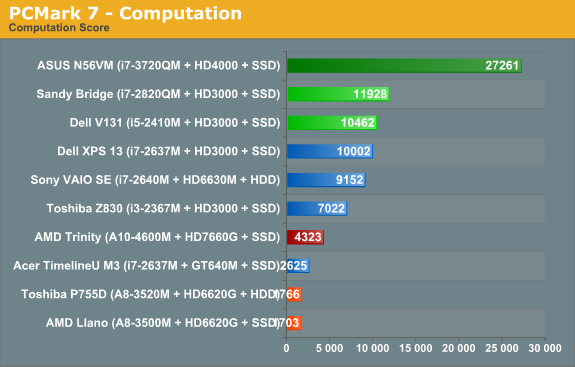
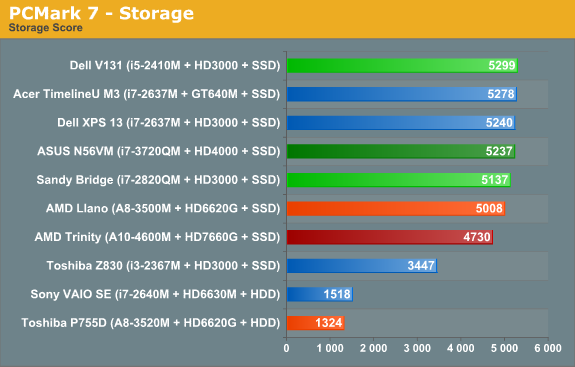
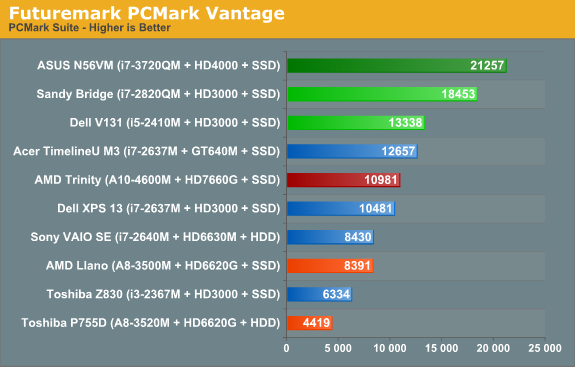
As noted earlier, we ran several other laptops through PCMark 7 and PCMark Vantage testing using the same Intel 520 240GB SSD, plus all the ultrabooks come with SSDs. That removes the SSD as a factor from most of the PCMark comparisons, leaving the rest of the platform to sink or swim on its own. And just how does AMD Trinity do here? Honestly, it’s not too bad, despite positioning within the charts.
Obviously, Intel’s quad-core Ivy Bridge is a beast when it comes to performance, but it’s a 45W beast that costs over $300 just for the CPU. We’ll have to wait for dual-core Ivy Bridge to see exactly how Intel’s latest stacks up against AMD, but if you remember the Llano vs. Sandy Bridge comparisons it looks like we’re in for more of the same. Intel continues to offer superior CPU performance, and even their Sandy Bridge ULV processors can often surpass Llano and Trinity. In the overall PCMark 7 metric, Trinity ends up being 20% faster than a Llano A8-3500M laptop, while Intel’s midrange i5-2410M posts a similar 25% lead on Trinity. Outside of the SSD, we’d expect Trinity and the Vostro V131 to both sell for around $600 as equipped.
A 25% lead for Intel is pretty big, but what you don’t necessarily get from the charts is that for many users, it just doesn’t matter. I know plenty of people using older Core 2 Duo (and even a few Core Duo!) laptops, and for general office tasks and Internet surfing they’re fine. Llano was already faster in general use than Core 2 Duo and Athlon X2 class hardware, and it delivered great battery life. Trinity boosts performance and [spoiler alert!] battery life, so it’s a net win. If you’re looking for a mobile workstation or something to do some hardcore gaming, Trinity won’t cut it—you’d want a quad-core Intel CPU for the former, and something with a discrete GPU for the latter—but for everything else, we’re in the very broad category known as “good enough”.


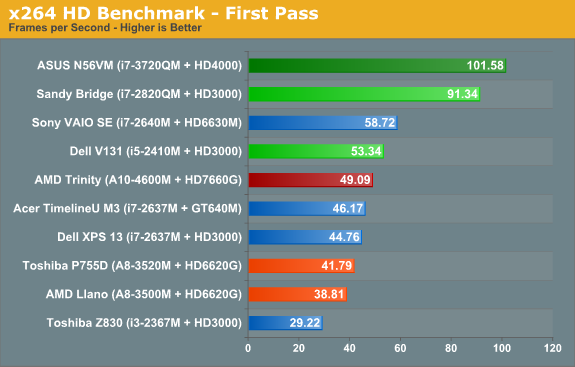
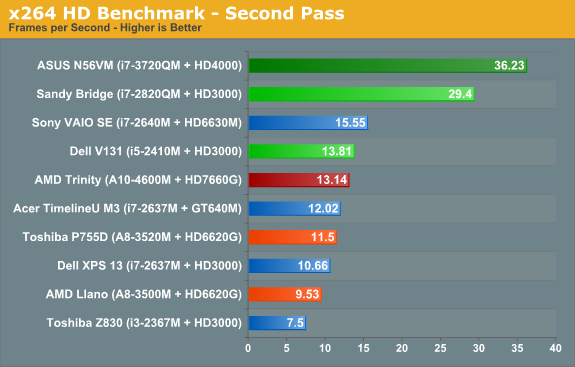
When we start drilling down into other performance metrics, AMD’s CPU performance deficiency becomes pretty obvious. The Cinebench single-threaded score is up 15% from 35W Llano, but in a bit of a surprise the multi-threaded score is basically a wash. Turn to the x264 HD encoding test however and Trinity once again shows a decent 15% improvement over Llano. Against Sandy Bridge and Ivy Bridge, though? AMD’s Trinity doesn’t stand a chance: i5-2410M is 50% faster in single-threaded Cinebench, 27% faster in multi-threaded, and 5-10% faster in x264. It’s a good thing 99.99% of laptop users never actually run applications like Cinebench for “real work”, but if you want to do video encoding a 10% increase can be very noticeable.

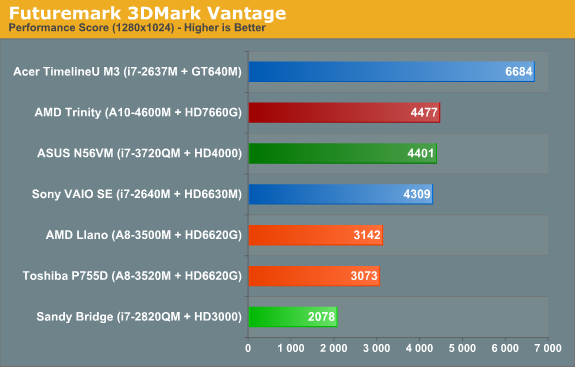
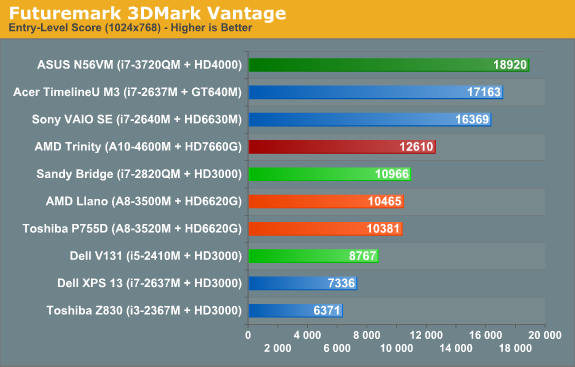
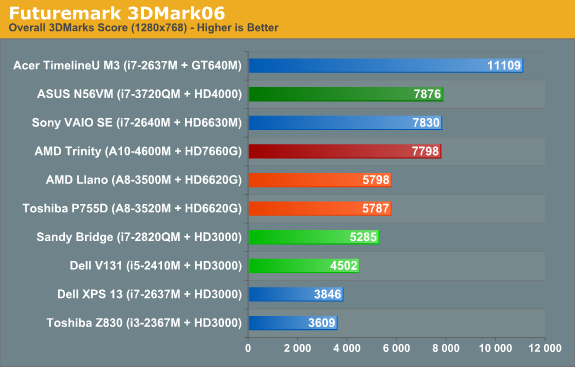
Shift over to graphics oriented benchmarks and the tables turn once again...sort of. Sandy Bridge can’t run 3DMark11, since it only has a DX10 class GPU, but in Vantage Performance and 3DMark06 Trinity is more than twice as fast as HD 3000. Of course, Ivy Bridge’s HD 4000 is the new Intel IGP Sheriff around these parts, and interestingly we see Trinity and i7-3720QM basically tied in these two synthetics. (We’ll just ignore 3DMark Vantage’s Entry benchmark, as it’s so light on graphics quality that we’ve found it doesn’t really stress most GPUs much—even low-end GPUs like HD 3000 score quite well.) We’ll dig into graphics performance more with our gaming benchmarks next.










271 Comments
View All Comments
Khato - Tuesday, May 15, 2012 - link
Really? The A10-4600m is going to be a $126 chip? 'Cause that's what a third of the tray price for an i7-3720QM is.BSMonitor - Tuesday, May 15, 2012 - link
You get 1/3 the performance on the CPU side.bji - Tuesday, May 15, 2012 - link
I don't know why I am bothing to respond to you, because your comments are all worthless, but I'd like to point out to anyone else who might be reading, that the CPU performance numbers are alot closer to 1/2 to 2/3 of the performance on the CPU side than 1/3.And 1/2 to 2/3 of Ivy Bridge CPU performance is *definitely* fast enough for 95% of users in 95% of circumstances, despite what trolls are claiming.
bji - Tuesday, May 15, 2012 - link
Sorry, forget I said 2/3. That was just one benchmark. Let's just leave it at 1/2.I think my point is still valid. 1/2 of Ivy Bridge performance at 1/3 cost is going to be very acceptable to the vast majority of people.
JarredWalton - Tuesday, May 15, 2012 - link
But the problem is you have to buy the whole laptop. If IVB goes for $350 and Trinity for $115, but the rest of the laptop ends up being $400, that means you get half the performance for 70% of the cost. And when Intel ships DC IVB chips for $150, we might be looking at 70% of the performance for 90% of the cost.My biggest fear with Trinity (if you couldn't tell from the conclusion) is that the laptop OEMs will price it too high. I think A10 is a decent part, provided you can get a reasonable set of laptop hardware for $600 or less. Anyway, we'll have to see what actually comes out and how much it costs.
bji - Tuesday, May 15, 2012 - link
Very good points. Then we have to throw in the question of how much the extra performance is worth to the user. We'd all take extra performance for free (assuming that it didn't come at a cost of heat or battery life or other features), but would you pay 10% more for more performance that you knew you didn't need? I don't think most consumers really think in these terms of course, marketing will sell these parts, not logic, but if we're trying to make price and value comparisons, we need to be aware that the goal is to get what you need for the least money, not more than you need for the least amount more money.JarredWalton - Tuesday, May 15, 2012 - link
I'd take Trinity with an SSD over Sandy Bridge with an HDD, provided I could get a good LCD and build quality thrown into the mix. Maybe HP will deliver with the upcoming Envy Sleekbooks?mrdude - Tuesday, May 15, 2012 - link
HP offered this with the Llano, granted they charge $150 for a 1080p screen... You can also opt to buy an aftermarket 1080p screen and DIY. The Asus Llano line was extremely popular because you can buy a $70 1080p matte finish screen and upgrade a crossfired Llano. For ~$600 you got great gaming performance and a 1080p screen. Those things sold like hotcakes too.Jarred, I think you neglected quite a bit in this review. The improvements we've seen in Llano > Trinity actually outweigh the improvements we've seen in SB > Ivy yet the latter also has the advantage of a die shrink. The perf-per-watt improvements are by far the biggest shocker here and are nothing short of unbelievable if you consider Bulldozer's power consumption.
While I understand using the 3720QM for the HD4000 benchmarks, why not delve into examining the Piledriver cores? There's very little info at all there with respect to what changed and what got better. What we got instead were synthetic benchmarks and a re-cap of the scores instead of some actual info. Hell, a monkey can run a benchmark but can that monkey run some meaningful benchmarks that test cache latency? AVX performance? Stress the IMC?Instead you're stating something that should be obvious (the weird multi-threaded cinebench score that actually makes sense when you consider it's a CMT design in Trinity therefore it lacks 2 FPUs compared to Llano) and that's supposed to be surprising?
I can understand wanting to get a review out in time and giving us a rough idea of performance, but this is Anandtech. We expect a bit more than "these are the scores and these are the numbers. Onto the next benchmark."
Spunjji - Wednesday, May 16, 2012 - link
I hear this.mikato - Wednesday, May 16, 2012 - link
I agree too (though the monkey part was a bit much). Maybe we can see a more in depth analysis of results, similar to Anandtech's treatment of AMD's new architecture but with hard results leading the analysis.